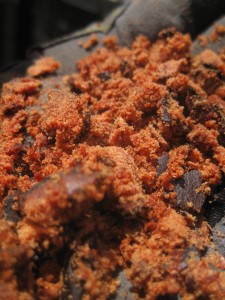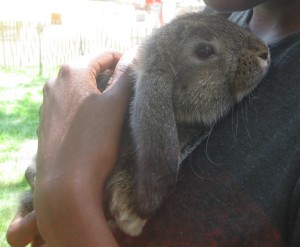I had the good fortune this summer of working with the Learning Gardens program of the City Parks Foundation, a program that hires public high school students to learn about garden basics while maintaining community gardens. One of our field trips took us the EarthMatters, a pretty fantastic composting facility on Governor’s Island.
Amongst the things learned:
1 – Avocado pits are hard as hell. And yet…
 …three weeks in a compost pile big enough to generate some real heat, and I could crush this pit in my palm with only a little more effort than it takes to squish a banana. I find this absolutely, completely fantastic, though no one else to whom I have detailed this little miracle seems quite as excited as me.
…three weeks in a compost pile big enough to generate some real heat, and I could crush this pit in my palm with only a little more effort than it takes to squish a banana. I find this absolutely, completely fantastic, though no one else to whom I have detailed this little miracle seems quite as excited as me.
2 – That dry, white coating you sometimes see on moldering mulch and compost?
 That’s actinomycetes. It’s a kind of bacteria that only shows up if you’re doing everything right. Essentially, the bacteria are so happy and healthy that they produce a network of cells visible to the human eye. The gas they produce is instantly recognizable as the smell of good soil after the rain. If you can see the bacteria, though, it’s time to wet down the pile.
That’s actinomycetes. It’s a kind of bacteria that only shows up if you’re doing everything right. Essentially, the bacteria are so happy and healthy that they produce a network of cells visible to the human eye. The gas they produce is instantly recognizable as the smell of good soil after the rain. If you can see the bacteria, though, it’s time to wet down the pile.
3 – Letting your chickens run free over the compost feeds them (because they pick out the bugs hanging on your food scraps) and tames in their manure the nitrogen, one of the Big Three components of fertilizers (not of the Allied Powers), so that it doesn’t burn your crops.
 4 – Rabbit manure, at 2.4% by dry weight, has more nitrogen than composted chicken manure (1.7%) and goat manure (1.5%), completely elevating my opinion of bunnies.
4 – Rabbit manure, at 2.4% by dry weight, has more nitrogen than composted chicken manure (1.7%) and goat manure (1.5%), completely elevating my opinion of bunnies.
 5 – Your chickens and vermicompost can co-exist.
5 – Your chickens and vermicompost can co-exist.
 6 – Chickens can sport Andy Warhol hairdos and tolerate being held like infants.
6 – Chickens can sport Andy Warhol hairdos and tolerate being held like infants.


